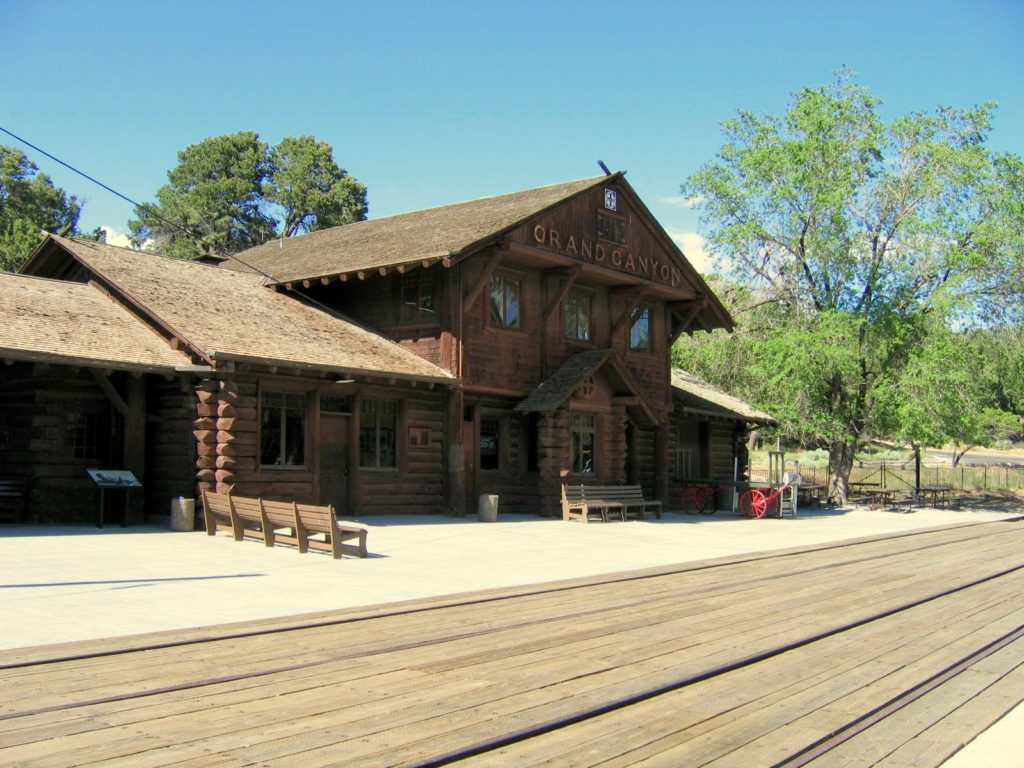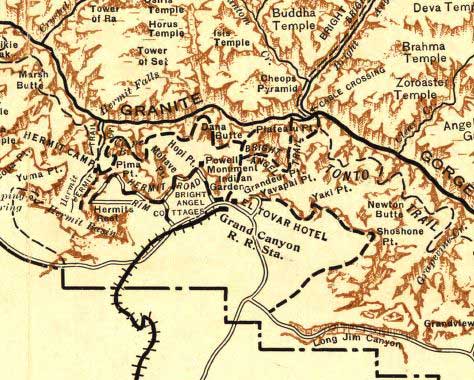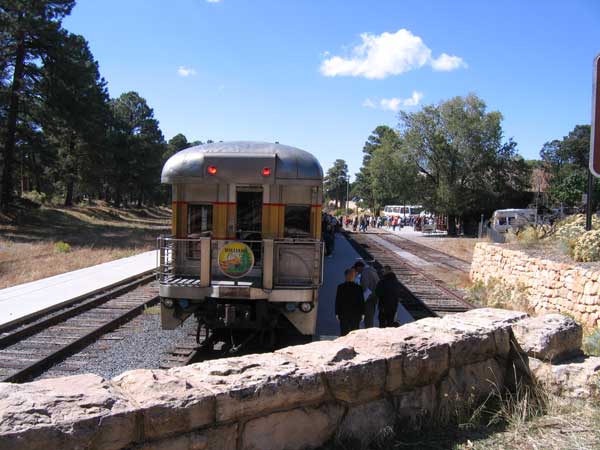How did you travel to the Grand Canyon? By car? By bus? By train?
Getting to the Grand Canyon, today and in years past, is a journey unto itself. Perhaps you drove to the park, from the south, steadily climbing up the slow grades of the Colorado Plateau, through pinyon-juniper woodlands to the pine and fir forests in northern Arizona. Your journey was in some ways much like that taken by early tourists to the canyon. Indeed, exploring transportation routes to the Grand Canyon is a great way to better understand the Grand Canyon and its importance in American history and culture.
The Grand Canyon Railway Depot, a large wooden structure sitting at the end of the railroad tracks just down the hill from El Tovar, is a noted landmark in the South Rim Village and a great place to start your historical adventure. As one of the oldest standing wooden train depots in the United States and the oldest in a U.S. National Park, the depot is more than wooden boards, train tracks, and benches. For over 100 years, this site has been an arrival and departure point for millions of tourists who have visited the Grand Canyon. To this day it is still a working train station as well as a testament to the role of railroads in establishing and promoting many western U.S. National Parks such as Yosemite, Mount Rainier, and Yellowstone.
he Atchison, Topeka and Santa Fe Railway and the building of the Grand Canyon Village are linked together. Looking at the Grand Canyon Railway Depot not only conjures images of nineteenth century tourists arriving at the canyon, it also is a built testament to the initial stages of developing the Grand Canyon Village.
During the nascent days of Grand Canyon tourism, visitors traveled to the Grand Canyon using a combination of trains and stagecoaches. In the late 19th century, many of Grand Canyon’s tourists came from east coast and Midwest cities after traveling on board Santa Fe trains heading west. Once they reached Williams, Arizona, the nearest train depot to the Grand Canyon, visitors would transfer from the train to the lumbering wooden stagecoaches for a 65 mile journey on dusty, bumpy roads to the South Rim of the Grand Canyon.
In 1901 the trip to the Grand Canyon became a much more comfortable journey. During that year, the Atchison, Topeka, and Santa Fe Railway (later known simply as the Santa Fe Railway) completed a new spur line of tracks connecting the depot at Williams, Arizona to Grand Canyon Village. Now visitors could travel by train right to the doorstep of one of America’s greatest natural and cultural wonders and forgo the long stagecoach ride to the canyon.
Although the canyon did not become a National Park until 1919, Americans had long heard of the area through travel journals and popular accounts. Inspired by the writings and imagery from early explorers and artists such as John Wesley Powell and Thomas Moran, and enticed by railroad advertising posters and brochures, visitors came by the thousands to see the Grand Canyon for themselves.
As the canyon’s popularity grew, the Santa Fe Railway continued to play an important part in Grand Canyon history. From 1905 to 1954 the Santa Fe Railway paid for and built many of the historic structures that are preserved at Grand Canyon Village today—often as partners with companies such as the Fred Harvey Company and federal agencies such as the U.S. Forest Service and the National Park Service.
By 1954, however, the railroad’s popularity had long since waned. Automobile travel proved far more popular a mode of travel for reaching the canyon since the 1920s. The Santa Fe Railway faced financial hardships and soon closed its operations at the Grand Canyon. The company donated its buildings to the National Park Service and sold all tourist-related properties to the Fred Harvey Company. The railroad continued its passenger service to the canyon until 1968 then cut back to only freight service. In 1972 the Santa Fe Railway discontinued all rail service to the Grand Canyon.
However, the story of the railroad continues to this day. Starting in 1989, the Santa Fe Railway’s tracks were revived with the formation of Grand Canyon Railway. Now tourists to the canyon can travel as some early park visitors did in train cars from Williams, Arizona to Grand Canyon Village.
If you visit the Grand Canyon take a few moments to stop at Grand Canyon Railway Depot. Step back into time and history as you explore this building, then step out into the bright sunlight of the canyon, walk up the stairs to El Tovar Hotel, and along the path to the canyon’s rim. The surprise and awe of seeing the canyon for the first time is still there, as it was for tourists in the early 20th century, as you take in the breathtaking view from the rim and across the canyon.
Written By Yolonda Youngs
References:
- Anderson, Michael F. Along the rim: A guide to Grand Canyon’s south rim from Hermit’s Rest to Desert View. Grand Canyon: Grand Canyon Association, 2001.




